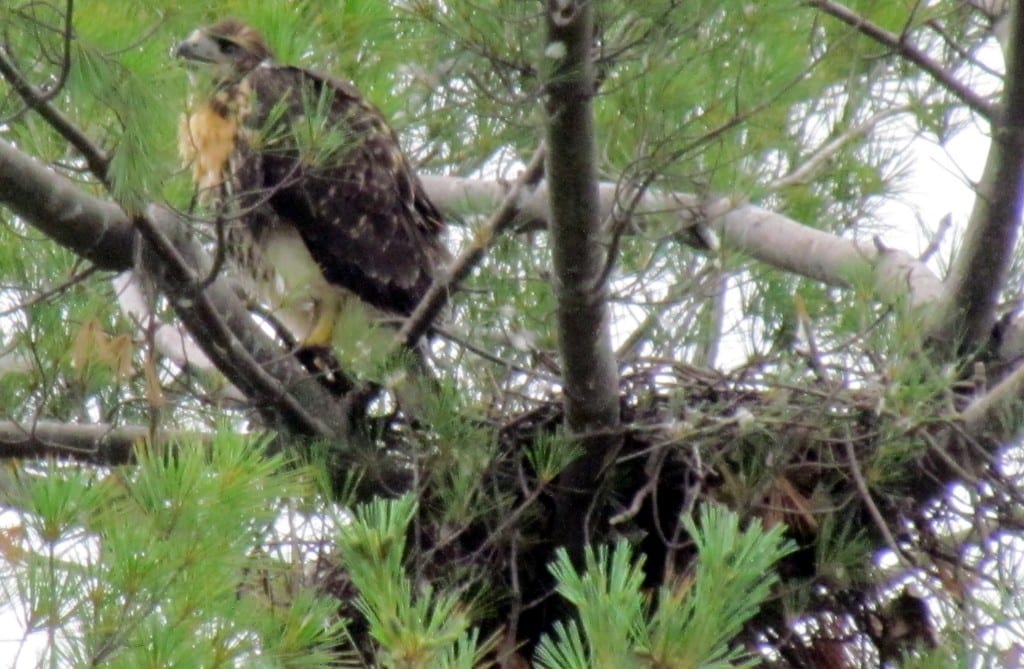Rescued Red-Tailed Hawk Rescued from Delamar West Hartford Hotel Site Has Died

Audio By Carbonatix

Baby Delamar on June 28, 2015. Photo credit: Mona Cavallero
The young red-tailed hawk was euthanized on Tuesday.

Baby Delamar on June 28, 2015. Photo credit: Mona Cavallero
By Ronni Newton
The dozen or so people who took a vested interest in a red-tailed hawk family that built a nest in a large pine tree on the site of the Delamar West Hartford Hotel construction site on Raymond Road received some sad news Tuesday afternoon from raptor expert Mary-Beth Kaeser of Horizon Wings.
Kaeser, who on July 10 rushed the not-yet-fledged baby hawk, who had been dubbed “Delamar,” from West Hartford to the Tufts Wildlife Clinic in Grafton, MA, after the West Hartford Fire Department and a Department of Energy and Environmental Protection (DEEP) wildlife biologist rescued it from its nest, informed the group that the bird had been euthanized.
“I am sorry to report that Delamar was euthanized humanely at Tufts this morning. His x-rays showed an advance case of aspergillosis. He was open mouth breathing even in the oxygen, and regurgitating everything he was fed,” Kaeser said in the email.
The decision to remove the hawk from its nest was made by a group of experts, including Kaeser and representatives from the Connecticut DEEP as well as members of the local Audubon Society chapter because the bird suddenly exhibited a marked changed in behavior and activity level. Several days prior to the rescue, “Delamar” had been active, hopping from branch to branch in the pine tree, and appeared ready to take flight, but then suddenly was listless.
When the bird was removed from the tree, its poor health was confirmed and its mouth was blood-filled.
The bird was initially treated for the suspected cause – rodenticide poisoning from injesting a rat – but that diagnosis could not be confirmed. Although its condition remained “guarded,” there were some initial improvements in the hawk’s health.
On Friday, July 17, a week after the young red-tailed hawk was removed from its nest, the bird’s condition was no longer improving. Doctors returned baby Delamar to an oxygen tank and began treatment with strong medications for the fungal lung infection aspergillosis because, although tests were inclusive, the bird was starting to show the physical symptoms of the infection.
Apergillosis is somewhat common in birds of prey, and can be brought about by a variety of factors including stress, malnutrition, or mold in the nest.
Hartford Audubon Society member Mona Cavallero said that one of the raptor rehabilitators she had spoken to while arranging the rescue told her that it appeared the mother hawk was extremely young, perhaps less than 2 years old, and may not have been able to hunt or feed the baby bird adequately.
Kaeser said previously in an email that “it is a sad fact that approximately two thirds of raptors do not make it through their first or second year.”
“The positive side, even though Delamar didn’t survive, was that this educated a lot of people,” Cavallero said. She and Mike Berzenski spent many hours watching the nest, and met a lot of people walking by the Blue Back Square site.
“Mike and I ran into a lot of people – ages 5 through 75 – who would stop by and ask. It was great exposure,” she said. Many people had never seen a red-tailed hawk, and would marvel at the fact that they and other wildlife can life alongside us, she said.
Construction crews had fenced off the tree that was home to the protected bird, and although excavation and other work was happening on the site, the nest was not disturbed. Workers had gotten into the habit of looking up at the young hawk and watching the parent hawks that soared around and perched on nearby buildings.
Once the baby was removed and the nest was abandoned, the parent hawks were no longer seen in the area, site manager Charles Bonser said. The tree was cut down on Monday morning.
“I want to thank everybody for their efforts and support in rescuing and trying to save this bird,” Kaeser said.
“Life for wild creatures in nature is always challenging and is often made more difficult by the activities of humans. We won’t ever know why this hawk had such difficulties that led to his demise, we can only hope that experiences such as these, for all of us, perhaps can give pause to consider humans’ place in the world of living organisms,” said Trinity College Professor of Biology Joan Morrison in an email expressing sadness about the bird’s death. “Our vast numbers and presence on almost every inch of the planet’s landscapes challenge all other species for sure. As we move past this experience, our turning attention in some way to make an improvement, even a little one, can help those still living. Keeping cats indoors, judicious use or eliminating use of chemicals, reducing our use of plastics, cleaning up local landscapes, all these things, when done by each of us, can make a difference,” said Morrison.
“Its death was not in vain,” Cavallero said. “This touched so many lives with awareness, education, and amazement.”
Like what you see here? Click here to subscribe to We-Ha’s newsletter so you’ll always be in the know about what’s happening in West Hartford!




[…] were hurdles to be overcome in the process, including delay caused by the nesting of a protected red-tailed hawk in a tree on the site, soil that was not “environmentally friendly” that needed to be removed, and a recent […]